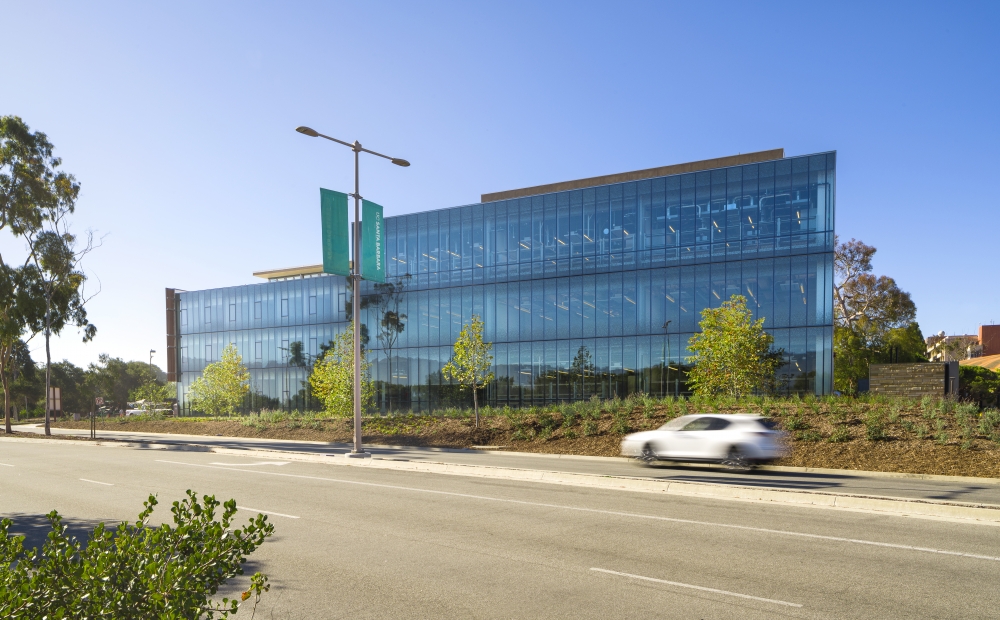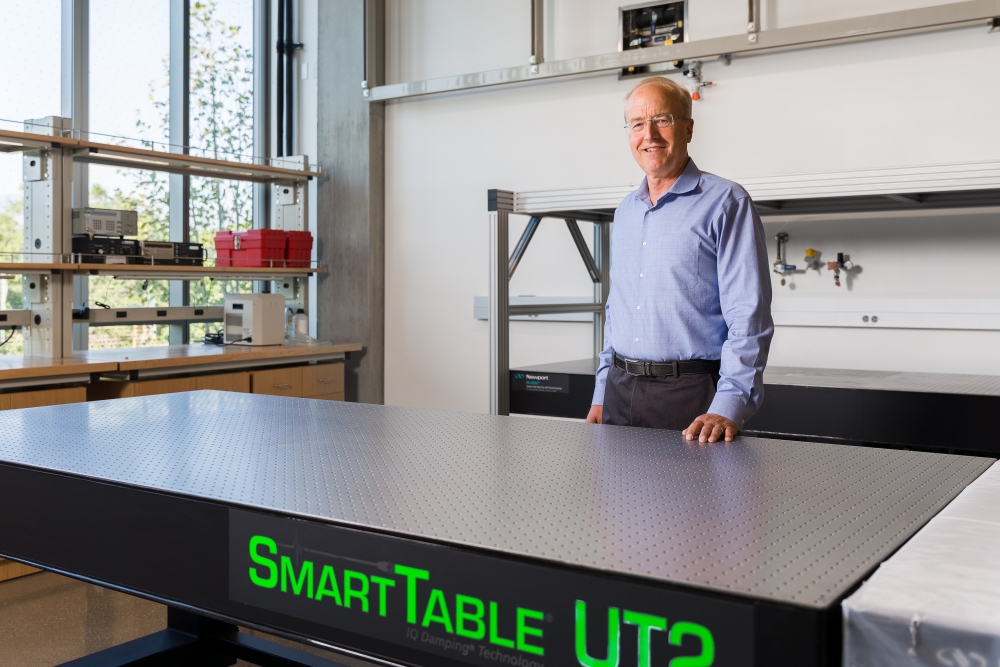Model of Efficiency
Their award-winning research has been the foundation for numerous energy-saving innovations, including bright and energy-saving white light LED lighting, more energy-efficient data-center communications and interconnects, and software that reduces energy usage in buildings worldwide. How fitting, then, that UC Santa Barbara’s Institute for Energy Efficiency is now housed in one such building.
The institute’s state-of-the-art new home, Henley Hall, is now complete and technically open for business, though the ongoing pandemic has limited its occupation to critical research projects in accordance with state and county public health guidelines.
The 50,000-square foot building — on track for LEED Platinum status — is itself a model of efficiency, with passive features such as solar shading and thermal insulation and active features including demand-controlled ventilation and a 25% reduction in lighting power density. More than 20% recycled materials were used in its construction.
Years in the making, the building was funded by donors — led by UCSB alumnus Jeff and Judy Henley, whose $50 million gift to the College of Engineering in 2012 sparked the project. More than $14.5 million was contributed by Silicon Valley-based alumna Shawn Byers and her husband, Brook.
“Judy and I wanted to support the priorities of the university and the College of Engineering by advancing the work of the Institute for Energy Efficiency,” Jeff Henley said of their initial motivation for the gift. “Getting them into state-of-the-art facilities was critical to achieving that goal. With Henley Hall now complete, the Institute is perfectly situated to create the new opportunities for research and teaching that can lead to pioneering, world-changing discoveries. They’ll also be nourishing and preparing a new generation of scientists and engineers — a generation that will surely push the boundaries of energy efficiency even further.”
“It is hard to find the words to thank Jeff and Judy Henley for our new Henley Hall,” said UC Santa Barbara Chancellor Henry T. Yang. “From the initial concept of establishing an Institute for Energy Efficiency to the idea of creating a new building as the home of IEE, Jeff provided the vision, guidance, financial support, and encouragement for well over a decade. We are also deeply grateful to Shawn and Brook Byers for joining forces with their inspirational vision and generosity. Our Institute for Energy Efficiency is now an exemplary model and flagship at the frontiers of energy efficiency, with the participation and collaboration of award-winning faculty across the disciplines. Thanks also go to Dean of Engineering Rod Alferness, Director John Bowers and faculty of the Institute, and our generous and visionary IEE Director's Council members, as well as all of our researchers, students, and staff who have contributed to the Institute since its launch in 2008.”
“Henley Hall provides critical research lab space in which our faculty and graduate students will discover and innovate solutions to address society’s major challenges, especially in the area of increased energy efficiency,” said Rod Alferness, dean of the College of Engineering. “Henley Hall sets UCSB up for success by establishing a cross-disciplined and collaborative environment, which is important because it brings faculty with diverse backgrounds and interests together in an effort to maximize the public benefit of their pioneering research. We are extremely grateful to Jeff and Judy Henley, and to Shawn and Brook Byers, for their generosity and support to make this state-of-the-art building possible.”
Designed by architectural firm Kieran Timberlake, Henley Hall consists of 17 labs (a combination of both wet and dry), collaborative break-out spaces, conference rooms, a 124-seat lecture hall, and 34 faculty and postdoctoral offices, as well as administrative offices. The three-story building by Sundt Construction Inc. will house 20 engineering faculty members and 100-plus graduate students.
The building features extensive natural lighting, adaptable laboratory space for evolving research needs and intelligent energy monitoring and control systems with interactive displays. It was built to LEED Platinum certification standards, with LED lighting and 40% energy savings over similar lab buildings.
If the building itself is a testament to the Institute’s existing body of work in the realm of energy efficiency, what will happen within its walls will constitute its next and future iterations.
“Energy efficiency is key to solving climate change and making U.S. industry more efficient in energy use and expense,” said John Bowers, director of the institute and a professor of electrical and computer engineering. “Henley Hall is essential to expanding UC Santa Barbara’s contributions to energy efficiency. It is important to bring together researchers to work together on important problems. The shared laboratories make this possible.”
Specifically, Bowers noted, IEE will now be able to expand its research in a number of important directions. Among them: a dedicated experimental data center that faculty members will use to experiment with more efficient servers, more efficient data communication, novel architectures and novel cooling approaches. In addition, there are several laboratories dedicated to quantum computing, and multiple laboratories focused on more efficient chemical processing, “a valuable industry with significant energy usage,” he said. “And of course, we will expand our solid-state lighting research at UC Santa Barbara.”






